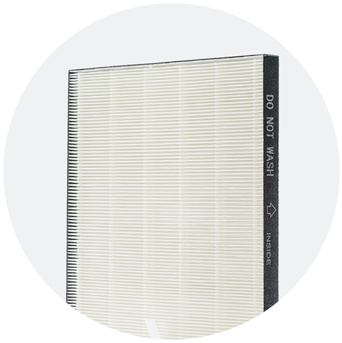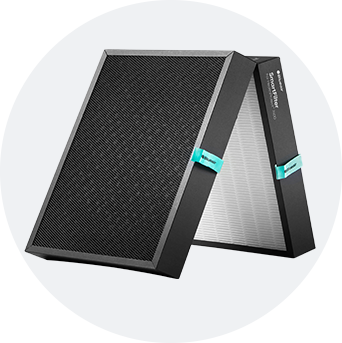
A dense HEPA filter with very tiny holes captures particles, but this means less clean air passes through the filter.
To push enough air through a dense HEPA filter, the fan must run at a higher speed, which creates more noise.
Running the fan at a higher speed also uses more energy.
Mechanical (HEPA) filtration on its own catches virus and bacteria – but can allow germ growth in the filter as the germs are not inactivated.
HEPA filtration catches 99.97% of particles sized 0.3 microns in size such as dust, pollen and smoke.

By combining two filtration technologies the filter doesn’t need to do as much of the work, so Blueair filters can be less dense - which delivers a uniquely high flow of clean air.⁴
A less dense filter material means that the air purifier fan can run at lower speeds, making a lot less noise while delivering a uniquely high flow of clean air.⁴
Running at lower speeds also uses a lot less energy - less than a traditional lightbulb.¹
Once captured in the filter, the combination of electrical charging and high air flow kills 99% of germs.
HEPASilent technology catches 99.97% of particles down to 0.1 microns in size such as viruses, bacteria and microplastics, while also removing larger particles such dust, pollen, smoke and pet dander.

Verifide by the Association of Home Appliance Manufacturers (AHAM) for performance and Clean Air Delivery Rate (CADR).

Inspired by our Swedish heritage, sustainability and quality are at the heart of everything we do.
It drives us to develop products that exceed industry standards for performance without losing sight of sustainability. We aim to use materials that minimize environmental impact whenever possible.
Blueair has now introduced products that have been designed with smarter, reactive features that help you stay on top of your indoor air quality.

Meet the Blueair families of air purifiers
Footnote
¹On lowest speed. Compared to an incandescent lightbulb.
²HealthProtect 7400 series shown to remove 99.99% of airborne SARS-CoV-2 in a 13 ft³ biosafety lab chamber. Not proven to kill SARS-CoV-2 or prevent transmission of COVID-19. Other Blueair air purifiers have not been tested against SARS-CoV-2.
³Based on internal testing of Blueair Classic 200-series on maximum fan speed in normal room temperature and humidity conditions
⁴HEPASilent™ technology provides a higher particle Clean Air Delivery Rate (pCADR) than conventional methods of only mechanical filtration (at a defined energy consumption and/or noise level). Particle CADR measures an air purifier’s delivery rate of particle free air (=”clean air”). The particle CADR tests are made according to GB/T18801-2015 standard on a particle size of below 0.3 micrometer.








